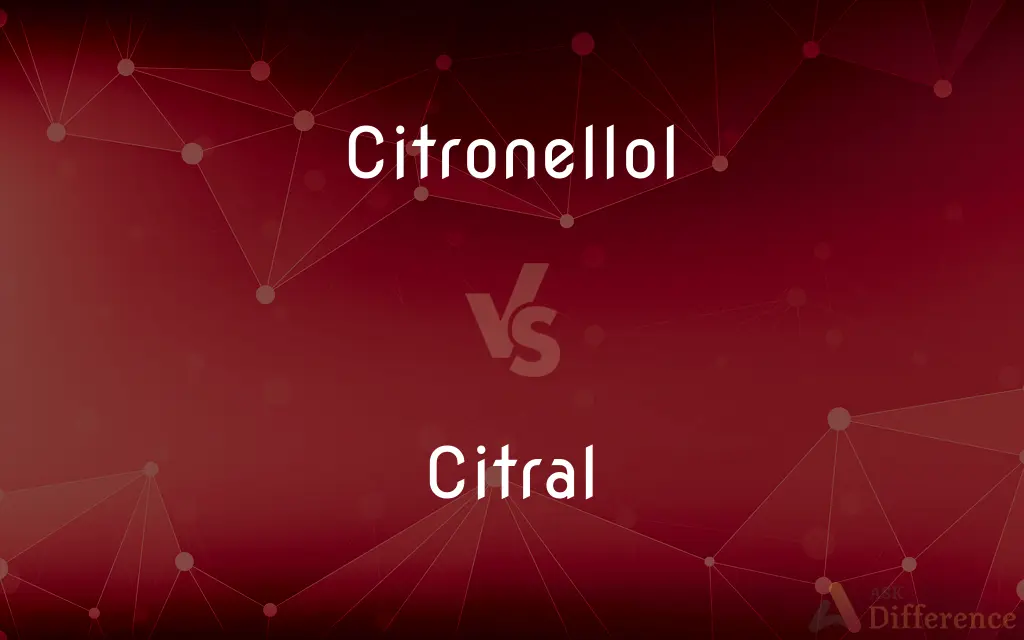Citronellol vs. Citral — What's the Difference?
Edited by Tayyaba Rehman — By Fiza Rafique — Updated on March 29, 2024
Citronellol is a natural alcohol-based fragrance compound found in roses and geraniums, known for its sweet, floral scent, while Citral is a key aroma compound in lemongrass, with a strong, fresh lemon scent, used in flavoring and fragrances.

Difference Between Citronellol and Citral
Table of Contents
ADVERTISEMENT
Key Differences
Citronellol, a monoterpene alcohol, is widely appreciated in the perfume and cosmetic industries for its pleasant, sweet, and rose-like fragrance. It's extracted from essential oils of plants like roses and geraniums, making it a staple in formulations designed to evoke a sense of natural floral beauty. On the other hand, Citral is an aldehyde with a potent, citrusy aroma that is characteristic of lemongrass. It is valued both for its refreshing scent and its flavoring properties, making it a popular ingredient in culinary arts, as well as in the manufacture of fragrances and household cleaners.
In terms of their chemical structures, Citronellol is noted for its alcohol group, which contributes to its sweet, floral scent profile, while Citral, being an aldehyde, has a structure that accounts for its sharp, lemony smell. This fundamental difference in their molecular makeup is what directs their respective uses and effects in products. While both are used in aromatherapy, Citronellol is often sought for its calming and uplifting effects, whereas Citral is pursued for its invigorating and antimicrobial properties.
The application of Citronellol extends beyond perfumery into skincare and insect repellents, leveraging its gentle nature and low toxicity. Its mildness makes it suitable for sensitive skin formulations and products aimed at providing a soothing fragrance. Citral, with its bold lemon scent, is extensively used in cleaning products and air fresheners, capitalizing on its strong, clean smell and its ability to act as a natural disinfectant.
Both compounds also play roles in flavoring; however, their contributions differ markedly due to their aromatic profiles. Citronellol can add subtle floral notes to food and beverages, enhancing complexity without overpowering. Citral, given its dominant lemon flavor, is used to impart a sharp, citrus taste, ideal for confectioneries, beverages, and culinary dishes requiring a zestful kick.
In the realm of natural and synthetic variations, Citronellol can be synthesized artificially, but its natural form is often preferred for its authenticity and depth of scent. Similarly, Citral can be produced synthetically, providing a cost-effective and consistent quality for industrial use. The preference for natural versus synthetic forms usually depends on the application, with natural extracts often prized in high-end perfumery and aromatherapy for their complexity and depth.
ADVERTISEMENT
Comparison Chart
Source
Roses, geraniums
Lemongrass, citrus fruits
Chemical Type
Monoterpene alcohol
Aldehyde
Scent Profile
Sweet, floral, rose-like
Strong, fresh, lemony
Applications
Perfumes, cosmetics, insect repellents
Flavoring, fragrances, cleaners
Properties
Calming, uplifting
Invigorating, antimicrobial
Use in Foods
Adds floral notes
Imparts lemon flavor
Synthetic Production
Possible, but natural preferred
Widely synthesized for consistency
Compare with Definitions
Citronellol
A fragrant alcohol found in roses.
Citronellol gives rose oil its distinctive sweet scent.
Citral
A lemon-scented compound in lemongrass.
Citral is responsible for the lemongrass tea’s lemony aroma.
Citronellol
Used in perfumes for its floral aroma.
The perfume boasted a base note of citronellol for its rose-like quality.
Citral
Key in citrus-flavored products.
Citral adds a fresh lemon zest to the candy.
Citronellol
Common in cosmetics and skincare.
Citronellol is favored in lotions for its gentle, soothing fragrance.
Citral
Used in household cleaners for its scent.
The cleaning spray contains citral for a natural lemon fragrance.
Citronellol
Can be synthesized or extracted naturally.
The candle used natural citronellol extracted from geraniums.
Citral
Offers antimicrobial properties.
Citral's antimicrobial action makes it a choice for natural disinfectants.
Citronellol
Ingredient in insect repellents.
Citronellol's effectiveness against mosquitoes is well-documented.
Citral
Synthetically produced for consistency.
Synthetic citral ensures the consistent flavor of the lemon soda.
Citronellol
Citronellol, or dihydrogeraniol, is a natural acyclic monoterpenoid. Both enantiomers occur in nature.
Citral
Citral, or 3,7-dimethyl-2,6-octadienal or lemonal, is either a pair, or a mixture of terpenoids with the molecular formula C10H16O. The two compounds are geometric isomers.
Citronellol
A colorless liquid, C10H20O, with a floral odor, derived from any of several essential oils, especially rose and geranium oils, or made synthetically and used extensively in perfumery.
Citral
A mobile pale-yellow liquid, C10H16O, derived from lemongrass oil and used in perfume and as a flavoring. Naturally derived citral consists of two geometric isomers, geranial and neral.
Citronellol
A natural acyclic monoterpenoid, occurring in citronella oils and used in perfumes and insect repellents.
Citral
Either of a pair of terpenoids, geranial and neral, that have the molecular formula C10H16O and are used in perfumery and flavourings.
Common Curiosities
Can Citronellol or Citral cause allergies?
While generally considered safe, some individuals may experience sensitivities or allergies, especially when used in high concentrations.
Can Citronellol be found in all rose species?
Not all rose species contain Citronellol; its presence depends on the specific variety and part of the plant.
Can Citronellol and Citral be used interchangeably?
No, due to their distinct scent profiles and properties, they serve different purposes in formulations.
Why are synthetic versions of Citronellol and Citral used?
Synthetic versions offer cost-effectiveness, consistency, and availability over natural extracts.
Are Citronellol and Citral natural ingredients?
Both can be found naturally in plants but are also produced synthetically for industrial use.
Do Citronellol and Citral have benefits in aromatherapy?
Yes, Citronellol is used for its calming effects, while Citral is sought for its invigorating and antimicrobial properties.
Are there environmental concerns with using Citronellol and Citral?
The environmental impact largely depends on the sourcing and production methods, with a preference for sustainably harvested and synthesized compounds.
Is Citral only used for its scent?
Besides its lemony scent, Citral is valued for its flavoring and antimicrobial properties.
Is there a difference in the cost of natural vs. synthetic Citronellol and Citral?
Natural extracts typically cost more due to the extraction process and lower yields compared to synthetic production.
How do Citronellol and Citral impact the flavor of food?
Citronellol can add a subtle floral note, while Citral imparts a distinct lemon flavor to foods and beverages.
Can Citronellol and Citral be found in everyday products?
Yes, they are commonly found in a wide range of products, from perfumes and lotions to foods, beverages, and cleaning agents.
How do Citronellol and Citral react with other ingredients in formulations?
Their interactions can vary, but they are generally formulated to be stable and complementary in the presence of other ingredients.
Are Citronellol and Citral considered safe for use in cosmetics?
Yes, when used in appropriate concentrations, both are considered safe for cosmetic use.
Share Your Discovery

Previous Comparison
Excretion vs. Osmoregulation
Next Comparison
Violin vs. CelloAuthor Spotlight
Written by
Fiza RafiqueFiza Rafique is a skilled content writer at AskDifference.com, where she meticulously refines and enhances written pieces. Drawing from her vast editorial expertise, Fiza ensures clarity, accuracy, and precision in every article. Passionate about language, she continually seeks to elevate the quality of content for readers worldwide.
Edited by
Tayyaba RehmanTayyaba Rehman is a distinguished writer, currently serving as a primary contributor to askdifference.com. As a researcher in semantics and etymology, Tayyaba's passion for the complexity of languages and their distinctions has found a perfect home on the platform. Tayyaba delves into the intricacies of language, distinguishing between commonly confused words and phrases, thereby providing clarity for readers worldwide.














































